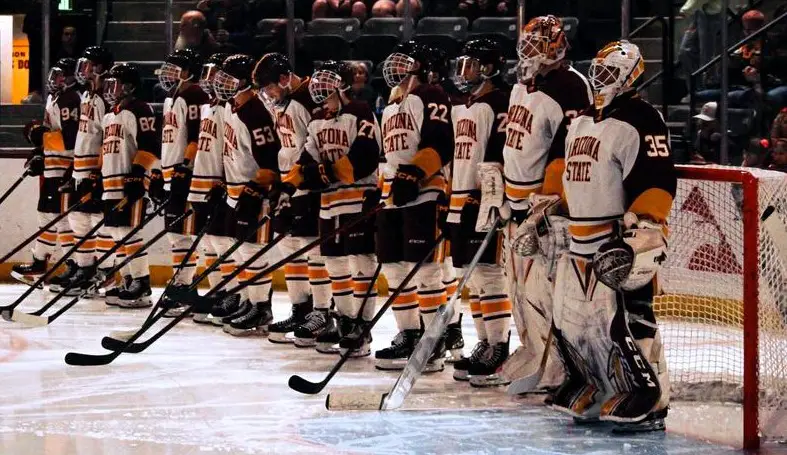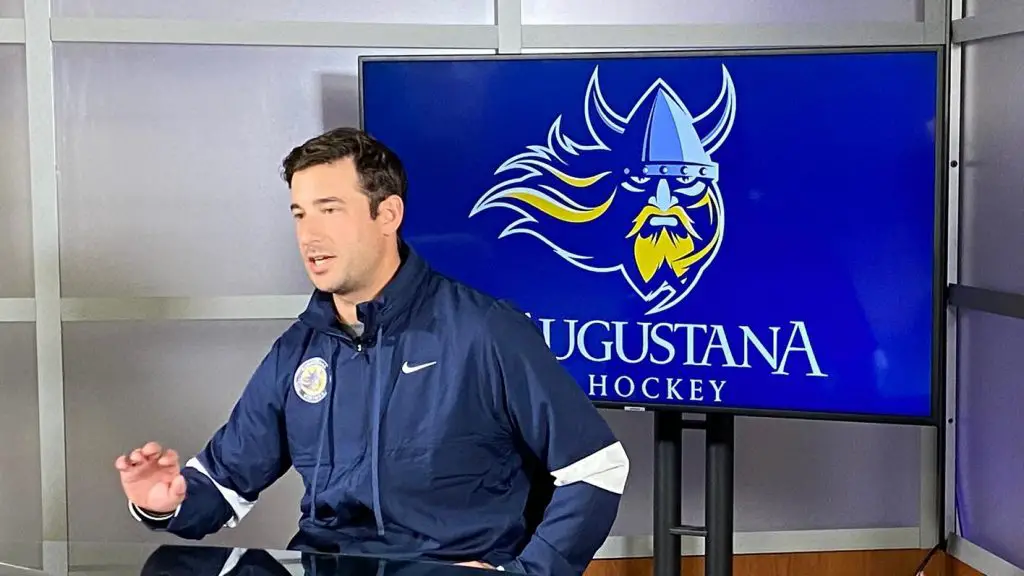
Realignment is on everyone’s mind in college sports these days.
Things are changing, and the majority of sports won’t resemble anything like their present state by this time next year. The ACC, the Big Ten, the Big 12, the SEC – they’re all going to be different, and the dominant news in the sports cycle isn’t going to stop until the geographical alignment, whatever it used to look like, is fully imploded within the ecosystem driving the biggest national sports.
Hockey fans are usually able to escape that crunch to a certain degree. The sport’s niche background built this nice, insulated cocoon, away from the garbled world’s overall headlines, and this season begins with its same six-conference structure. The geographic look and feel is very different from 10 years ago, but the relative charm associated with the game’s foundation is unbroken and unshaken compared to the conference butterfly effect raging in other areas.
That doesn’t stop realignment or expansion talk from constantly occurring, but the basic understanding of the general factors driving those wheels requires a certain analysis and thoughtfulness. Trends are emerging out of a necessity felt throughout the college hockey world, but their existence holds a thoughtfulness rooted within the institutional and league hierarchies.
The plates won’t stop shifting, but they also won’t simply settle until everyone understands how college hockey is handling its fluid situation. The times are changing, but the sport’s fluidity retains some of the greatest pieces of its culture because where it’s headed is still grounded in where it came from.
“The membership was open to the conversations over the course of the last year,” said NCHC commissioner Heather Weems. “So we started asking what it would look like, what they brought to the table and to get a sense of how the story played out of how they fit. We continued the conversation with our board of directors and presidents and with our athletics council, and we really felt like it was a good time. We wanted to ensure that [expansion] brought stability to our conference, and we wanted to be committed to growth and growing hockey and being at a place where we invested in markets.”
It was undoubtedly a great fit for both parties, and the NCHC’s offseason splash to welcome Arizona State greatly breached the divide between the traditional powerhouses and the new, emerging game that underwent a radical realignment during the 2010s. The Sun Devils had earned a national tournament berth as an independent, but the strength of the NCHC came largely from its history, much of which was built before its schools realigned into the new league.
The league itself was an instant splash, and the first season in 2013 coincided with a nine-year run of Frozen Four appearances. North Dakota, Denver, and Minnesota Duluth won four consecutive national championships, and the fifth title by Denver occurred five years after the Pioneers defeated the Bulldogs in an all-conference final.
This past year’s Frozen Four was the first time that the league missed the premier event, but adding Arizona State reinforced each of those pillars. That previously-mentioned hockey tradition, even without a trophy to its credit, instead gained one of the fastest-growing teams in the nation, and the heights once envisioned by head coach Greg Powers delighted onlookers who readily saw the connection between the league and a rising power with an NHL-caliber arena.
“Arizona State made the NCAA tournament back in 2019, and at that point, we had determined that as a conference – and I was at St. Cloud at the time – we were still relatively new at that point, and we needed to get our feet underneath us a little bit [before expanding],” said Weems. “That program checked a lot of boxes, but they didn’t have a facility and didn’t have a tradition, so we weren’t sure how it was going to play out. Since that time, it was always in the back of our head that there might come a time when things aligned, and over the past number of years, we’ve demonstrated that we’re solid and stable from a financial standpoint. Arizona State demonstrated, particularly with the opening of Mullett Arena last fall, that they were committed to hockey at a really high level.”
Arizona State opened the right door for the NCHC, and the league returned the favor by curing the Sun Devils’ long-term solution. The program itself is continuously growing, and the conference is gaining new traction in a location served by the majority of its constituents.
“Once you get further west, you know that the amount that our schools take on for travel is very different than schools in the Northeast,” Weems said. “The reality is that most of our schools in areas like Minnesota can find non-conference games that are close, but schools like Denver and Colorado College are flying no matter what. If you’re Omaha, you’re going to fly. What we were able to do was keep the same number of conference games [for next year] by doing a pod system, and we aren’t adding any additional flight for any of our institutions.
“The nice part about Arizona State is that they became one of the easiest places to fly into for every one of our markets since every primary airport has a direct flight to Phoenix,” she added, “and a lot of them have a pretty good alumni base in Phoenix with people who spend their winters in Arizona.”
Not all moves are alike, but the idea that a new program could fluidly slot into a league is the reason why new traditions are quick to fit into the older college hockey world. The upcoming season, for example, is the fourth straight year with a new team hitting the ice for the first time, but the way Augustana University approached its hockey program is in line with the regional, grassroots approach that built the older eras of the teams of its future, CCHA-based home.
This year marks the fourth consecutive season with a new Division I program, and the large bulk of the programs represent colleges that are significantly smaller than Arizona State, which itself hit the ice three years after Penn State kicked off this whole realignment conversation with the introduction of its program. Those were the first two new teams since Robert Morris University joined college hockey in 2004, and the new teams, including Augustana University, are more in line with a more regional, grassroots approach to the game.
“It will be incredibly rewarding [to hit the ice for the first game],” said Josh Morton, the director of athletics for the Sioux Falls, S.D.-based institution. “This started in April of 2021 for us, and as we built up the community support to announce it that subsequent October, it’s just been about hitting milestones along the way. Each one makes it more real. We had our first official practice, and seeing 27 guys on the ice for Augustana University was incredible. We welcomed the team to the first day of classes, and going back to the introduction of [head coach] Garrett Raboin and getting into the CCHA, it’s pretty awesome to be [within] a month away from dropping the puck.”
Augustana’s journey to college hockey echoed what happened 20 years ago when Robert Morris University built a winning tradition by capitalizing on opportunities. Even back then, the Colonials arrived in Division I amidst a realignment shift, and an open slot in College Hockey America logically led the team to effectively replace Findlay after the Oilers dropped their program altogether.
The CHA eventually crashed, but the move into Atlantic Hockey alongside Niagara helped the program earn its highest reward with its first conference championship and national tournament berth in 2014. Even after the quizzical disbanding of the program in the post-Covid aftermath, RMU’s presence and build – and this year’s re-debut as the league’s “new” team – offered a blueprint for other programs to follow.
“For us, college hockey is a differentiator,” said Morton, the director of athletics at Augustana University. “It’s so much deeper than our campus. It’s deeper than 27 guys on the ice playing hockey games. It’s about separating our university. We’re the first team in [South Dakota] to have a college hockey program competing at the Division I level, and it’s housed in Sioux Falls, which is a dynamic and growing community. It’s really a differentiator for us in higher education, which is a competitive marketplace.”

The Vikings are tied to a hockey-mad market, but their debut is both different and unique from the way Long Island, Stonehill, Lindenwood and St. Thomas built their respective programs. Of that group, Augustana is the only one that isn’t in a pro hockey state, but Sioux Falls is physically located close to the Minnesota-Iowa border, which puts it right smack in the middle of junior hockey’s United States Hockey League footprint. To that end, the Sioux Falls Stampede offers some existing infrastructure, but the ability to tie college hockey into a junior hockey market is a unique opportunity.
“Sioux Falls is growing significantly,” Morton said. “And we have a vibrant economy and progressive community. So to offer terrific high level entertainment was important to us as a great community partner, and then to build an on-campus arena was really meaningful to us. To see that come to fruition later this season is incredibly gratifying.”
Decision-makers at Augustana understood hockey through that background, and the CCHA’s internal familiarity with the market created another western border for a league that arose when its members wanted a more geographically-centralized conference. Like Arizona State in the NCHC, the short distance trip to Minnesota State and the abbreviated distances to Bemidji State and St. Thomas make South Dakota an impression, and the Vikings’ build made it easier for those teams – and the ones situated throughout the Upper Peninsula and beyond – accept a new program.
“It’s about value and what kind of value a school can add,” Morton admitted. “I’m really proud of our university because startups don’t always get into a league right away. It was a big deal for us, and I appreciate [CCHA commissioner] Don Lucia because our conversations were really positive from the start. They wanted Augustana in the CCHA, and the schools agreed. Whether it’s an odd or even number, there’s going to be an adjustment, and it was certainly a factor, but I think that our value to the league and being a part of the CCHA overlaid that growth.”
Both Arizona State and Augustana will compete this year as independents, but they will hit the ice with opportunities to play against their future competition. The Sun Devils, who open up on Oct. 6 with a game against in-state club rival Arizona, later play Miami, Denver, and Colorado College, while the Vikings play two games against every CCHA member this year. They will play each other in mid-January when Augustana travels to Arizona for two games at Mullet Arena.



